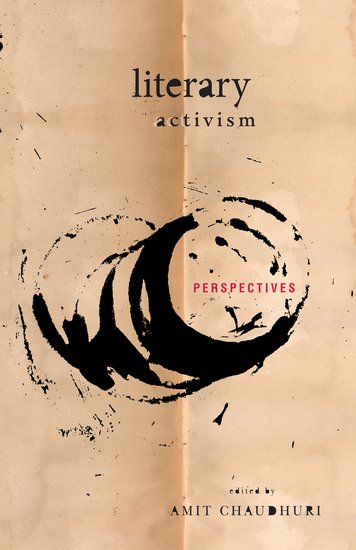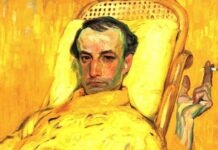A review of Literary Activism: Perspectives ed. Amit Chaudhuri (Oxford University Press, 2017)
There’s a debate going on among some of my English department colleagues, centered on the following questions. What responsibility do faculty trained primarily in American and British literatures have to the teaching of English literatures of the non-West? How should English literature of South Asia or East Africa, for instance, be contextualized in terms of the relevant subcontinental and regional literatures in other languages? On what grounds might texts originally written in Bengali, Urdu, Swahili, or Arabic be taught in an English department? Is knowledge of the original language in which a text was written required for teaching it in translation? If so, what constitutes such knowledge?
I’ve been thinking about these questions lately through the terms offered by Literary Activism, an idiosyncratic volume that collects proceedings from a 2015 Oxford symposium and even some of the email debriefing that followed. The title refers to a broad constellation of activities and object relations that motor critical engagements with literature in and beyond the academy. Literary activism is not quite “championing,” except when it is. It is not literature in service of what we conventionally understand as the political, nor is it simply an affirmation of the politics of aesthetics. Literary activism has a newly urgent brief given how markets and information technology have debased contemporary discourses on the literary; by that same token, it has been practiced as long as writers have written and readers have read. In editor and symposium-convener Amit Chaudhuri’s words, literary activism bears “a strangeness that echoes the strangeness of the literary…[it] may be desultory, in that its aims and values aren’t immediately explicable” (2017a: 6).
Contributors to Literary Activism include scholars, journalists, publishers, creative writers, and literary critics. In response to Chaudhuri’s capacious opening gambit, they variously explore literary activism as “the crucial work that seeks to restore the importance of the literary to the public sphere” (Majumdar 2017: 122); the championing of writers by colleagues who believe “unconditionally in the value of [their] work” (Zecchini 2017: 20); a “critical” practice that can reorient debates on literary tradition and the modern (R. Chaudhuri 2017: 190); a counterpart to market activism (Graham: 2017); exemplified by the “passionate advocacy” of poetry translation (Mckendrick 2017: 249); a combination of literary “karma or work…jnana, or knowledge…and srishti, or creation” (Chakravorty 2017: 268); and “activism on behalf of an idea of literature” (Cook 2017: 298). These accounts are not mutually exclusive. Rather, they are consistent with how literature bridges and confounds private-public distinctions: traversing the figural space within and between minds, on the one hand, and passing materially through hands and institutions, on the other.
Literary activism can be private, as in the case of English-Marathi poet Arun Kolatkar, who Laetitia Zecchini describes as having practiced his art in “a hostile or indifferent environment” (2017: 25). Kolatkar and his fellow poets “did not need the market or the public to know that their work was outstanding” (30); in fact, neglect by mainstream publishers was the enabling condition of their work. Spurning market logics, Kolatkar and his contemporaries published in their own presses, retained control over all aspects of production, and actively translated their and others’ works. They were “creating a world of their own, with their own standards and audience, however limited” (30). Zecchini’s translation of Kolatkar began with a private intimation as well, through an unexpected encounter with his poetry that she describes in terms of falling in love.
Literary activism is also public, as in Amit Chaudhuri and Peter McDonald’s joint nomination of Arvind Krishna Mehrotra, a superlative poet, translator, and critic, for the post of 2009 Oxford Professor of Poetry. That nomination brought together novelists, scientists, historians, political thinkers, philosophers, and numerous other “well-wishers” in service of a campaign that was, Chaudhuri stresses, never going “to win”; it was “a deliberate long shot that should succeed” (2017b: 240, 245). That it didn’t succeed (the post ultimately went unfulfilled, a turn of events involving an alleged smear campaign by Ruth Padel against Derek Walcott, regarding his history of sexual harassment) was the point. By highlighting the work of Mehrotra, Chaudhuri and McDonald were able to lay bare the extra-literary considerations operative in the filling of posts like that of Oxford Professor.
Zecchini’s and Amit Chaudhuri’s essays situate literary activism between acts of private creation and public consumption, between literature as a practice of living and literature as products in circulation. They contribute to the volume’s larger discussion of the relationship between literary activism and the “market activism” of publishing houses, agents, and booksellers. David Graham offers a normative account of market activism as the work of “experts” who are able “to bring new, fresh, and important voices to readers around the world” (2017: 80). Graham, a publisher, describes himself as both “a businessman whose business has been making literary works sell” and “a midwife to literary talent” (73). This tellingly mixed language captures the simultaneously opportunistic and beneficent nature of publishing.
For most contributors, however, market activism is the province of those less interested in literature than in what sells. “[H]ow do we establish what is authentic,” Dubravka Ugrešić asks, “and what a product of market compromise?” (2017: 208). “[C]an any amount of activism really re-energize [literature’s] declined importance in the contemporary public sphere?” Saikat Majumdar wonders (141). Tim Parks laments the pervasive conflation of literary worth with accessibility, exemplified by how publishers and literary-festival organizers celebrate the success of texts that they themselves have been responsible for promoting (“How pleasant, then, to convince oneself that what reaches out to everyone is also the best” [2017: 157]). Reflecting on her own circumscribed position as a “Croatian writer who lives in Amsterdam,” Ugrešić wryly observes the mass culture industry’s unwillingness to read transnational literatures in anything other than national terms (208).
Critiques of the culture industry, pandering publishers, and the marketplace of least-common-denominators are not new. But the contributors to Literary Activism go further by routing the literature-market binary through a significant third term: the academy. Derek Attridge describes how, over the course of many years, he championed the work of J.M. Coetzee and Zoë Wicomb, writing critical essays and a monograph about the former, and planning a conference and editing a volume about the latter (Attridge also nominated Wicomb for the Windham-Campbell Prize, which she received). It is the kind of affirmative academic attention that Gayatri Chakravorty Spivak has paid to Mahesweta Devi’s stories, or for that matter, which Majumdar has given to Amit Chaudhuri’s novels. All of this, Attridge speculates, “must have had some effect on publishers’ decisions, prize-awarding bodies, reviewers, and all the other agents in the literary marketplace” (2017: 59).
What is the nature of this effect? How does academic attention to certain writers inflect their position in the literary marketplace—and vice versa? There is a long history of scholarship on literature’s relations to the market (Brier 2017), but it is only recently that the academy is taking stock of its particular mediation of those relations. As Andy Hines observes in an essay on the new institutionalism, only now are literary critics “willing to admit that we have been pushed around all along” (2018: np). Two remarkable paragraphs in Amit Chaudhuri’s essay strike at the heart of this vexed triangulation. He writes:
By the late 1980s…departments of English…looked with some prejudice upon value and the symbols of value, such as the canon; problematized or disowned terms such as ‘classic’ and ‘masterpiece’; often ascribed a positive political value to orality, which it conflated with non-Western culture, and a negative one to inscription or ‘good writing’, which it identified with the European Enlightenment. Some of this was overdue and necessary. (2017b: 224)
Chaudhuri is referencing two concurrent phenomena here. For one, a spate of works including Pierre Bourdieu’s rules of art (1992), John Guillory’s work on canon formation (1993), and Pascale Casanova’s world republic of letters (1999) problematized accepted terms and modes of literary valuation. At the same time, English studies was being transformed by critical theory, postcolonialism, feminism, and cultural studies. Construed positively, the discipline underwent significant internal reformation; viewed more suspiciously, it metabolized the oppositional knowledge projects that had emerged to contest its disciplinary hegemony.
Chaudhuri’s passage then shifts subtly in focus:
Meanwhile, publishers robustly adopted the language of value – to do with the ‘masterpiece’ and ‘classic’ and ‘great writer’ – that had fallen out of use in its old location, fashioning it in their own terms. And these were the terms that academics essentially accepted. They critiqued literary value in their own domain, but they were unopposed to it when it was transferred to the marketplace. Part of the reason for this was the language of the market and the language of the publishing industry were…populist during a time of anti-elitism…For example: from the 1990s onward, publishers insisted there was no reason that literary novels couldn’t sell…What they meant was that, in the new mainstream category of ‘literary fiction’, only literary novels that sold well would be deemed valid literary novels. Academics neither exposed this semantic conflict nor challenged the way literary value had been reconfigured. (2017b: 224-225)
This is “the genius of market activism” that “disinherits and revivifies” terms of literary value that have fallen out of favor in the academy (A. Chaudhuri 2017b: 226). The result is that the status of Harold Bloom’s latest entrant into the Western canon is rightly debated, but first-time novelists debut “instant classics” and “modern masterpieces” that are unblinkingly received as such. And it’s not just that an indiscriminate public is being told what to read by Oprah, Reddit, or for that matter the Times. Now, rather than an Attridge elevating a Wicomb, the market tells the academic who and what is worthy of study. This transformation in market-academy relations has most significantly impacted those who teach and study contemporary and non-Western literatures. Chaudhuri’s passage closes with a note on such academics:
When, in response to political changes in the intellectual landscape, they extended the old canon and began to teach contemporary writers, or novelists from the former colonies, they largely chose as their texts novels whose position had been already decided by the market and its instruments, such as certain literary prizes. (2017b225)
Chaudhuri is treading lightly here, but anyone familiar with his creative and critical oeuvre knows who he is talking about. The South Asian and South Asian diasporic writers most frequently taught and researched in the Anglo-American academy are Booker winners (Salman Rushdie, Arundhati Roy, Aravind Adiga), Pulitzer winner (Jhumpa Lahiri), and a Nobel Laureate (V.S. Naipaul). High profile nominations can bring otherwise minor texts to prominence, as do reviews in outlets like the Times or New Yorker. Scholars wondering which contemporary works will stand the test of time (as if the test of time were an adequate arbiter of literary value) turn to prizes and bestseller-lists in order to identify what is worthy of study. This is the context in which we “subsist on a sense that the lineage of the Indian English novel is an exemplary anthology of single works, rather than a tradition of cross-referencing, borrowing, and reciprocity” (A. Chaudhuri 2017b: 229). This is the context in which we become literary activists.
This is also the context in which South Asian literature, to continue with the above example, becomes equated with South Asian literature in English, when in fact, as contributors to Literary Activism discuss, South Asian literature in English is part of a rich South Asian literary archive and must be studied in the context of the subcontinent’s multilingual traditions. For example, Rosinka Chaudhuri’s essay on the literary sphere of early 19th-century Bengal shows how “contentions between the major literary languages of India, including the classical and folk languages, nouveau urban and mixed languages, colonial and ‘native’ languages, played an instrumental role in the many negotiations between modernity and literary craft” (2017: 190). Zecchini’s approach to Arun Kolatkar and Amit Chaudhuri’s reading of Arvind Krishna Mehrotra are attuned to such negotiations in the 20th-century context.
Which brings me back to the questions at the top of this essay. Originally hired as a Global Anglophonist, I am one of only two members of our literature faculty whose primary scholarly field is neither American nor British literature. I am also on the executive committee of an undergraduate major in World Literature that is housed in another college (formally and institutionally at our university, the “world” doesn’t belong to English). I therefore approach the debate about teaching texts in translation from my position at the interstices of the “Global Anglophone” and “World Literature,” which are distinct paradigms for the teaching of non-Western literatures. The former admits only texts written in English and is arguably a renomination of the postcolonial; the latter conventionally allows for the teaching of non-English texts in English translation.
Surprising even myself, I have become an advocate—I dare say an activist—for the inclusion of non-Anglophone works of “World Literature” in English translation alongside works of “Global Anglophone” literature in our seminars and Masters exam lists. Why? Because we cannot teach and administer exams as if Chinua Achebe (a usual suspect) is only in conversation with Joseph Conrad, as if Things Fall Apart has nothing to say to Tayeb Salih’s Season of Migration to the North (translated from Arabic). Because graduate students reading Rushdie and Roy (more usual suspects) should very well know Intizar Hussain (translated from Urdu) and Kamala Suraya (translated from Malayalam). Because, as Roanne Kantor puts it, “no coherent historiography of the Global Anglophone can be built within the ‘Anglophone’ itself” (2018: np).
My advocacy has been met by a complicated resistance. Faculty who oppose the teaching of texts in translation worry that the delinking of these texts from their source languages is intellectually irresponsible. They argue that our contemporary reading practices have, in Tim Parks’ words, “drastically weakened and in many cases altogether severed” “the old connections that linked writer to community” (149-150), and that teaching literature in translation will only exacerbate this problem. This critique, along with the suspicion that World Literature is “the educational equivalent of a shopping-mall food court” (Damrosch 2013: 153, 158), is worth heeding. But what is the alternative? The Global Anglophone circumvents the vexed politics of translation, but it valorizes Booker- and Nobel-prize winning writers like Rushdie, Wole Soyinka, and Nadine Gordimer. To return to Amit Chaudhuri’s argument, the Global Anglophone is preoccupied with Anglo-centric international prizes and the “instant classics” they create. It is by nature overly focused on the contemporary, as colonial histories prefigure the relevant 20th and 21st-century texts.
Rigid adherence to the Global Anglophone rubric reflects an impoverished theory of translation as well, a topic discussed at length in Literary Activism. It is of course true, as Parks notes, that translations are not “always enriching” (170). By that same token, as Ugrešić writes, “Every translation is not only a multiplication of misunderstandings, but also a multiplication of meanings” (204). Translation is “cultural catalyst” (McKendrick 2017: 249). It is a practice “meant to forge affiliations and connections, to assert bonds of kinship, and to clear a space, however minor or marginal, for [writers] and their predecessors—who are turned into contemporaries by the process of translation itself” (Zecchini 2017:31). Electing not to read literature in translation because one risks misunderstanding is as suspect as assuming translation is a one-to-one “process of recoding” (Cook 2017: 322).
That the above isn’t obvious is a reflection on the conservatism of English in some quarters, and maybe even literary scholarship more generally. In its final significant through-line, Literary Activism theorizes criticism as an alternative to scholarship, and amateurism as an alternative to expertise. Expert publishers and expert scholars who mediate between author and reader are distinguished from “amateur” critics—the category is Majumdar’s—who read and write without consideration of prize-winners, bestseller lists, market, or promotion-and-tenure-committee approval. For Majumdar, scholars are defined by their commitment to the objective, to their “archive of study” (2017: 115). By contrast, the critic “celebrates and foregrounds her subjective self” and practices literary interpretation as “a creative act” (115). Unlike professional scholars, whose archival considerations are overdetermined, amateur literary critics are characterized by their interdisciplinarity, willingness to take intellectual risks, and love of literature. They practice what Attridge describes as an “affirmative criticism, one that operates…to understand, explore, respond to, and judge what is of value in”—as opposed to the value of—“works of literature” (2017: 51).
Majumdar is currently editing, with Aarthi Vadde, a volume called The Critic as Amateur that further develops the distinctions between private and public, scholar and critic, literature, market, and academy offered here. That volume (to which I have contributed) also includes essays by Attridge, Rosinka Chaudhuri, and McDonald. Taken together, the pair of books, Literary Activism and The Critic as Amateur, suggest another scene in which literary activism is performed: transnational collaborators deciding over symposia coffee breaks what to publish together next.
I have come to think of much of the work I do as an English professor as literary activism. Certainly, my advocacy of an expansive literature curriculum is activism on behalf of an idea of literature. This essay is a minor piece of activism as well, a gesture of affirmative criticism that aspires to shore up the links between two projects and draw attention to them both. It can be painful at times, both urgent and pointless-feeling, and it might never be “properly remembered or noticed” (A. Chaudhuri 2017b: 244). Say what you want about love. In the first and final instance, literary activism is a form of labor.
_____
Ragini Tharoor Srinivasan is an assistant professor of English and Social, Cultural, and Critical Theory at the University of Arizona. She has also taught at the University of Nevada, Reno, and at the University of California, Berkeley, where she earned a PhD in Rhetoric in 2016. A former magazine editor and award-winning journalist, Srinivasan has contributed essays and criticism to scholarly, public, and semi-public venues on three continents. More from www.raginitharoorsrinivasan.com
_____
References
- Attridge, Derek. 2017. “The Critic as Lover: Literary Activism and the Academy,” Literary Activism: Perspectives, edited by Amit Chaudhuri. New Delhi: Oxford University Press.
- Brier, Evan. 2017. “The Literary Marketplace,” Oxford Research Encyclopedia of Literature. Oxford University Press.
- Bourdieu, Pierre. 1992. The Rules of Art: Genesis and Structure of the Literary Field, trans. by Susan Emanuel. Stanford: Stanford University Press.
- Casanova, Pascale. 1999. The World Republic of Letters, trans. By M.B. DeBevoise. Cambridge: Harvard University Press.
- Chakravorty, Swapan. 2017. “Literary Surrogacy and Literary Activism: Instance from Bengal,” Literary Activism: Perspectives, edited by Amit Chaudhuri. New Delhi: Oxford University Press.
- Chaudhuri, Amit. 2017a. “A Brief Background to the Symposium, and Some Acknowledgments,” Literary Activism: Perspectives, edited by Amit Chaudhuri. New Delhi: Oxford University Press.
- –. 2017b. “The Piazza and the Car Park: Literary Activism and the Mehrotra Campaign,” Literary Activism: Perspectives, edited by Amit Chaudhuri. New Delhi: Oxford University Press.
- Chaudhuri, Rosinka. 2017. “The Practice of Literature: The Calcutta Context as a Guide to Literary Activism,” Literary Activism: Perspectives, edited by Amit Chaudhuri. New Delhi: Oxford University Press.
- Cook, Jon. 2017. “Literary Activism: Where Now, What Next?” Literary Activism: Perspectives, edited by Amit Chaudhuri. New Delhi: Oxford University Press.
- Damrosch, David. 2013. “World Literature in a Postliterary Age,” Modern Language Quarterly 74.2.
- Graham, David. 2017. “‘Market Activism’: A Publisher’s Perspective,” Literary Activism: Perspectives, edited by Amit Chaudhuri. New Delhi: Oxford University Press.
- Guillory, John. 1993. Cultural Capital: The Problem of Literary Canon Formation. Chicago: The University of Chicago Press.
- Hines, Andy. 2018. “The Material Life of Criticism,” Public Books, Jan. 22, http://www.publicbooks.org/the-material-life-of-criticism/, accessed Sept. 13, 2018.
- Kantor, Roanne. 2018. “Even If You Gain the World: South Asia, Latin America, and the Unexpected Journey to Global English (working title).” Unpublished manuscript, last modified October 17, 2018. Microsoft Word file.
- Majumdar, Saikat. 2017. “The Amatory Activist,” Literary Activism: Perspectives, edited by Amit Chaudhuri. New Delhi: Oxford University Press.
- Mckendrick, Jamie. 2017. “Forms of Fidelity: Poetry Translation as Literary Activism,” Literary Activism: Perspectives, edited by Amit Chaudhuri. New Delhi: Oxford University Press.
- Parks, Tim. 2017. “Globalisation, Literary Activism, and the Death of Critical Discourse,” Literary Activism: Perspectives, edited by Amit Chaudhuri. New Delhi: Oxford University Press.
- Ugrešić, Dubravka. 2017. “Transnational vs. National Literature,” trans. David Williams. Literary Activism: Perspectives, edited by Amit Chaudhuri. New Delhi: Oxford University Press.
- Zecchini, Laetitia. 2017. “Translation as Literary Activism: On Invisibility and Exposure, Arun Kolatkar and the Little Magazine ‘Conspiracy,’” Literary Activism: Perspectives, edited by Amit Chaudhuri. New Delhi: Oxford University Press.
*Editorial Note (Nov 5, 2018): A broken link was fixed and a line that originally read “…I am the only member of our literature faculty whose primary scholarly field is neither American nor British literature” was changed to read: “…I am one of only two members of our literature faculty whose primary scholarly field is neither American nor British literature.”




